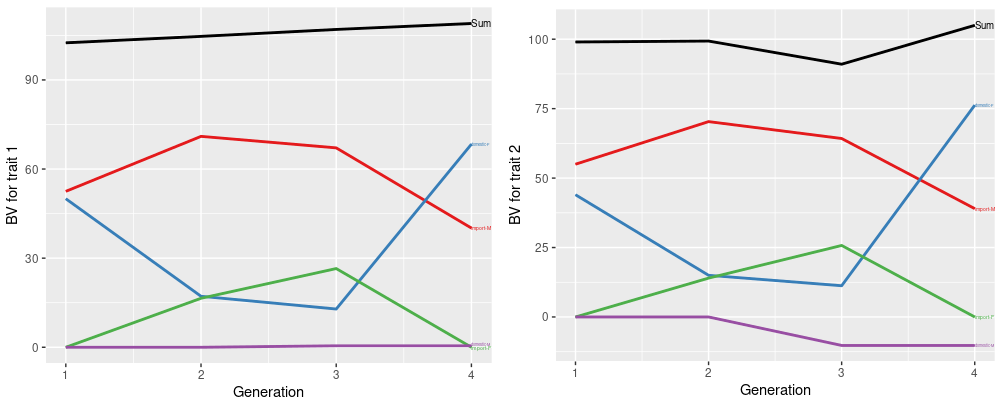Overview
AlphaPart is a sophisticated R package for partitioning genetic trends (Obšteter et al. 2021), facilitating a deeper understanding of genetic gain in breeding programs. This method, rooted in the innovative works by Garcia-Cortes et al. (2008) and recent advancements, allows breeders and researchers to dissect the contributions of various selection paths to overall genetic progress.
Features
- Implements cutting-edge methods for partitioning both genetic means and variances.
- Includes functions for data manipulation, ensuring compatibility with diverse data sets.
- Offers advanced tools for visualizing genetic trends and partitioning results.
- Provides robust summarizing capabilities to interpret complex genetic data.
New in This Version
- Incorporates recent methods for partitioning genetic variance, providing a more holistic view of breeding values (Oliveira et al. 2022).
- Improved algorithms for more accurate and insightful analysis of breeding programs.
- New visualization features for a more intuitive understanding of genetic trends.
Instalation
# The easiest way to get AlphaPart
install.packages("AlphaPart")Development version
To get a bug fix or to use a feature from the development version, you can install the development version of AlphaPart from GitHub.
install.packages("devtools")
devtools::install_github("AlphaGenes/AlphaPart")Contributing to AlphaPart
Please, follow the contribution guide at Contributing file to know how to start contributing to AlphaPart.
Usage
library(AlphaPart)
## Partition additive genetic values by country and sex
AlphaPart.ped$country.gender <- with(AlphaPart.ped, paste(country, gender, sep="-"))
(res <- AlphaPart(x=AlphaPart.ped, colPath="country.gender", colBV=c("bv1", "bv2")))
#> Size:
#> - individuals: 8
#> - traits: 2 (bv1, bv2)
#> - paths: 4 (domestic-F, domestic-M, import-F, import-M)
#> - unknown (missing) values:
#> bv1 bv2
#> 0 0
#> Partitions of breeding values
#> - individuals: 8
#> - paths: 4 (domestic-F, domestic-M, import-F, import-M)
#> - traits: 2 (bv1, bv2)
#> Trait: bv1
#> IId FId MId gen country gender country.gender bv1 bv1_pa bv1_w bv1_domestic-F bv1_domestic-M bv1_import-F bv1_import-M
#> 1 A 1 domestic F domestic-F 100 0.0 100.0 100.000 0.0 0.0 0.000
#> 2 B 1 import M import-M 105 0.0 105.0 0.000 0.0 0.0 105.000
#> 3 C B A 2 domestic F domestic-F 104 102.5 1.5 51.500 0.0 0.0 52.500
#> 4 T B 2 import F import-F 102 52.5 49.5 0.000 0.0 49.5 52.500
#> 5 D 2 import M import-M 108 0.0 108.0 0.000 0.0 0.0 108.000
#> 6 E D C 3 domestic M domestic-M 107 106.0 1.0 25.750 1.0 0.0 80.250
#> 7 U D 3 import F import-F 107 54.0 53.0 0.000 0.0 53.0 54.000
#> 8 V E 4 domestic F domestic-F 109 53.5 55.5 68.375 0.5 0.0 40.125
#> Trait: bv2
#> IId FId MId gen country gender country.gender bv2 bv2_pa bv2_w bv2_domestic-F bv2_domestic-M bv2_import-F bv2_import-M
#> 1 A 1 domestic F domestic-F 88 0.0 88.0 88.00 0.00 0.0 0.0
#> 2 B 1 import M import-M 110 0.0 110.0 0.00 0.00 0.0 110.0
#> 3 C B A 2 domestic F domestic-F 100 99.0 1.0 45.00 0.00 0.0 55.0
#> 4 T B 2 import F import-F 97 55.0 42.0 0.00 0.00 42.0 55.0
#> 5 D 2 import M import-M 101 0.0 101.0 0.00 0.00 0.0 101.0
#> 6 E D C 3 domestic M domestic-M 80 100.5 -20.5 22.50 -20.50 0.0 78.0
#> 7 U D 3 import F import-F 102 50.5 51.5 0.00 0.00 51.5 50.5
#> 8 V E 4 domestic F domestic-F 105 40.0 65.0 76.25 -10.25 0.0 39.0
## Summarize population by generation (=trend)
(ret <- summary(res, by="gen"))
#> Summary of partitions of breeding values
#> - paths: 4 (domestic-F, domestic-M, import-F, import-M)
#> - traits: 2 (bv1, bv2)
#> Trait: bv1
#> gen N Sum domestic-F domestic-M import-F import-M
#> 1 1 2 102.5000 50.00000 0.0 0.0 52.500
#> 2 2 3 104.6667 17.16667 0.0 16.5 71.000
#> 3 3 2 107.0000 12.87500 0.5 26.5 67.125
#> 4 4 1 109.0000 68.37500 0.5 0.0 40.125
#> Trait: bv2
#> gen N Sum domestic-F domestic-M import-F import-M
#> 1 1 2 99.00000 44.00 0.00 0.00 55.00000
#> 2 2 3 99.33333 15.00 0.00 14.00 70.33333
#> 3 3 2 91.00000 11.25 -10.25 25.75 64.25000
#> 4 4 1 105.00000 76.25 -10.25 0.00 39.00000
## Plot the partitions
p <- plot(ret, ylab=c("BV for trait 1", "BV for trait 2"), xlab="Generation")
print(p)







